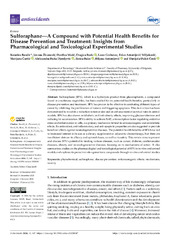Приказ основних података о документу
Sulforaphane—A Compound with Potential Health Benefits for Disease Prevention and Treatment: Insights from Pharmacological and Toxicological Experimental Studies
| dc.creator | Baralić, Katarina | |
| dc.creator | Živanović, Jovana | |
| dc.creator | Marić, Đurđica | |
| dc.creator | Božić, Dragica | |
| dc.creator | Grahovac, Lazar | |
| dc.creator | Antonijević-Miljaković, Evica | |
| dc.creator | Ćurčić, Marijana | |
| dc.creator | Buha-Đorđević, Aleksandra | |
| dc.creator | Bulat, Zorica | |
| dc.creator | Antonijević, Biljana | |
| dc.creator | Đukić-Ćosić, Danijela | |
| dc.date.accessioned | 2024-01-25T12:49:34Z | |
| dc.date.available | 2024-01-25T12:49:34Z | |
| dc.date.issued | 2024 | |
| dc.identifier.issn | 2076-3921 | |
| dc.identifier.uri | https://farfar.pharmacy.bg.ac.rs/handle/123456789/5516 | |
| dc.description.abstract | Sulforaphane (SFN), which is a hydrolysis product from glucoraphanin, a compound found in cruciferous vegetables, has been studied for its potential health benefits, particularly in disease prevention and treatment. SFN has proven to be effective in combating different types of cancer by inhibiting the proliferation of tumors and triggering apoptosis. This dual action has been demonstrated to result in a reduction in tumor size and an enhancement of survival rates in animal models. SFN has also shown antidiabetic and anti-obesity effects, improving glucose tolerance and reducing fat accumulation. SFN’s ability to activate Nrf2, a transcription factor regulating oxidative stress and inflammation in cells, is a primary mechanism behind its anticancerogenic and antidiabetic effects. Its antioxidant, anti-inflammatory, and anti-apoptotic properties are also suggested to provide beneficial effects against neurodegenerative diseases. The potential health benefits of SFN have led to increased interest in its use as a dietary supplement or adjunct to chemotherapy, but there are insufficient data on its efficacy and optimal doses, as well as its safety. This review aims to present and discuss SFN’s potential in treating various diseases, such as cancer, diabetes, cardiovascular diseases, obesity, and neurodegenerative diseases, focusing on its mechanisms of action. It also summarizes studies on the pharmacological and toxicological potential of SFN in in vitro and animal models and explores its protective role against toxic compounds through in vitro and animal studies. | sr |
| dc.language.iso | en | sr |
| dc.publisher | MDPI | sr |
| dc.relation | This paper was supported by the project “Improving anticancer immunotherapy efficacy of CAR-T cells or PD-1/PD-L1 inhibitors by combining immune modulators” | sr |
| dc.relation | The Ministry of Education, Science, and Technological Development of the Republic of Serbia, in the framework of scientific cooperation with the People’s Republic of China (451-03-1203/2021-09). | |
| dc.rights | openAccess | sr |
| dc.rights.uri | https://creativecommons.org/licenses/by/4.0/ | |
| dc.source | Antioxidants | sr |
| dc.subject | phytochemical | sr |
| dc.subject | sulforaphane | sr |
| dc.subject | disease prevention | sr |
| dc.subject | anticancerogenic effects | sr |
| dc.subject | mechanisms | sr |
| dc.subject | toxicity | sr |
| dc.title | Sulforaphane—A Compound with Potential Health Benefits for Disease Prevention and Treatment: Insights from Pharmacological and Toxicological Experimental Studies | sr |
| dc.type | article | sr |
| dc.rights.license | BY | sr |
| dc.citation.volume | 13 | |
| dc.citation.issue | 2 | |
| dc.identifier.wos | 001172106700001 | |
| dc.identifier.doi | 10.3390/antiox13020147 | |
| dc.identifier.pmid | 38397745 | |
| dc.identifier.scopus | 2-s2.0-85187273413 | |
| dc.identifier.fulltext | http://farfar.pharmacy.bg.ac.rs/bitstream/id/15540/Sulforaphane_A_Compound_pub_2024.pdf | |
| dc.type.version | publishedVersion | sr |

